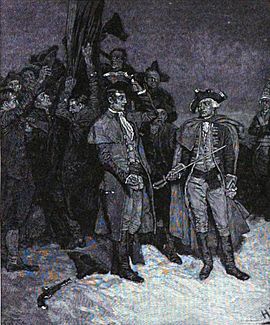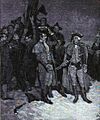Capture of Fort William and Mary facts for kids
Quick facts for kids Capture of Fort William and Mary |
|||||||
|---|---|---|---|---|---|---|---|
| Part of the American Revolutionary War | |||||||
 Surrender of Fort William and Mary by Howard Pyle |
|||||||
|
|||||||
| Belligerents | |||||||
| Militia of the Province of New Hampshire | |||||||
| Commanders and leaders | |||||||
| John Langdon John Sullivan Alexander Scammell |
Captain John Cochran |
||||||
| Strength | |||||||
| 300+ | 6 | ||||||
The Capture of Fort William and Mary was an important event in New Hampshire that happened on December 14, 1774. American colonists, called Patriots, from the Portsmouth area, led by John Langdon, took over Fort William and Mary. They overcame a small group of six British soldiers.
The Patriots seized the fort's gunpowder. This powder was then sent to different towns in the colony. It was meant to be used in the upcoming fight against Great Britain. The next day, on December 15, 1774, Patriots led by John Sullivan raided the fort again. This time, they took many cannons.
This event was one of the first open actions of the American Revolutionary War. It was also the only battle to happen in the state of New Hampshire.
Why the Fort Was Captured
Before the American Revolutionary War began, tensions were growing. The British government was worried about all the weapons in New England. They feared these weapons could lead to fighting.
On October 19, 1774, King George III made a secret rule. This rule stopped weapons and gunpowder from being sent to America. News of this rule quickly reached the Patriot leaders in New England.
The port in Boston had been closed by the British. This was a punishment for the Boston Tea Party. Because of this, the Portsmouth Committee of Correspondence stayed in close touch with Boston's Patriot leaders.
In Massachusetts, there was a scare in the fall of 1774. British soldiers, called redcoats, took provincial gunpowder. This event was known as the Powder Alarm. Patriots worried the British would try to take more colonial supplies.
Patriots in Rhode Island moved their weapons from a fort in Newport to a safer place inland. They did this without any problems. In Massachusetts, rumors spread that British troops from Boston were coming to Fort William and Mary. They were supposedly going to seize its powder and weapons.
On December 13, 1774, Paul Revere rode to Portsmouth. This was four months before his more famous ride in Massachusetts. He went to warn the people. Once in Portsmouth, Revere met with Samuel Cutts, a local merchant. Together, they planned how to take the fort with other local Patriots.
The Patriot Raids
On the morning of December 14, Patriots from New Castle tried to trick their way into Fort William and Mary. But they were not successful. Meanwhile, John Langdon walked through Portsmouth with a drummer. He gathered a crowd to go to the fort.
Several hundred men answered his call. They headed for the fort by way of the Piscataqua River. Only one British officer, Captain John Cochran, and five soldiers were at Fort William and Mary. Even though they were greatly outnumbered, they refused to give up to the Patriots.
When Langdon's men rushed the fort, the defenders fired three cannons. They also shot their muskets. Patriots quickly climbed over the walls. Cochran's men fought hand-to-hand, but they were soon overwhelmed. Langdon's volunteers broke into the powder house. They took about 100 barrels of gunpowder. They also cheered as they pulled down the fort's large British flag.
Several people were injured during the fight, but no one died. Captain Cochran and his men were held for about an hour and a half. After that, they were released.
The next day, more rebel forces arrived in Portsmouth. They came from other parts of the colony and from Maine. These forces were led by John Sullivan, with Major Alexander Scammell. They returned to the fort late on the night of December 15. The fort was taken over again without any gunfire. This time, muskets, other military supplies, and 16 cannons belonging to the King were removed. British authorities called these raids a very serious crime against the king. Sullivan later received payment for his actions from the Continental Congress.
What Happened Next
The British Governor, John Wentworth, asked for help from Boston. In response, a British warship, the Canceaux, arrived on December 17. Its job was to keep the peace in New Hampshire. Another ship, the Scarborough, arrived on December 19 with many Royal Marines aboard.
The Governor and his family had to leave their home in Portsmouth in the summer of 1775. They took shelter in the fort, protected by British warships. Britain eventually gave up on the colony of New Hampshire. They decided to focus on the fighting in Massachusetts. The British abandoned the fort, taking its remaining equipment to Boston along with Governor Wentworth.
The supplies the Patriots captured in December 1774 were very useful. New Hampshire's forces used them against the British military. This included using them during the Siege of Boston and at the Battle of Bunker Hill. However, some supplies, including cannons, were left behind by the Patriots. These were later used by the British forces.
After the British left the fort during the Revolution, the Patriots likely renamed it Fort Hancock. A plaque at the fort today honors this event. It says, "In commemoration of the first victory of the American Revolution. The capture, on this site of Fort William and Mary, 14–15 December 1774."
Images for kids
-
Surrender of Fort William and Mary by Howard Pyle


